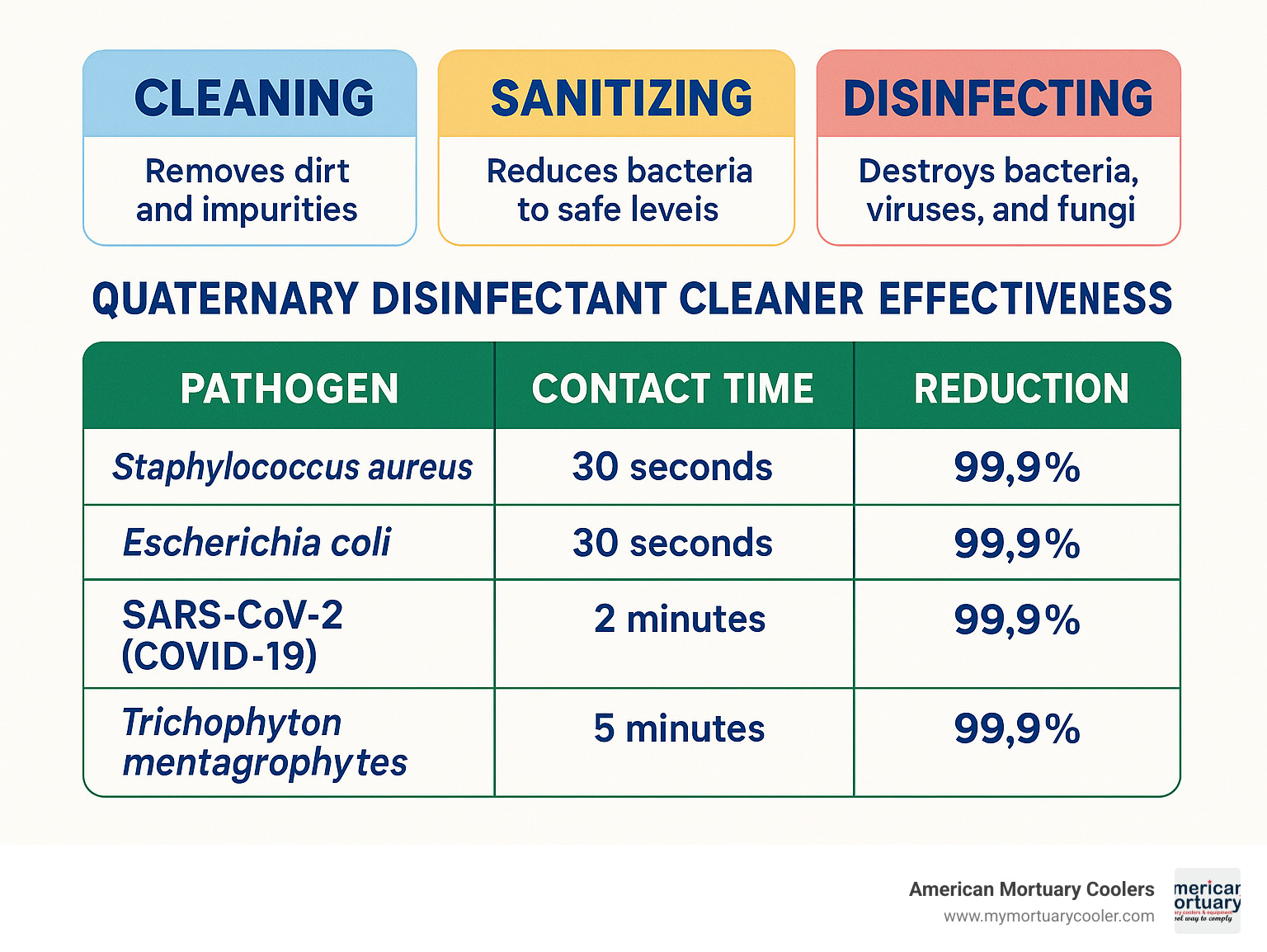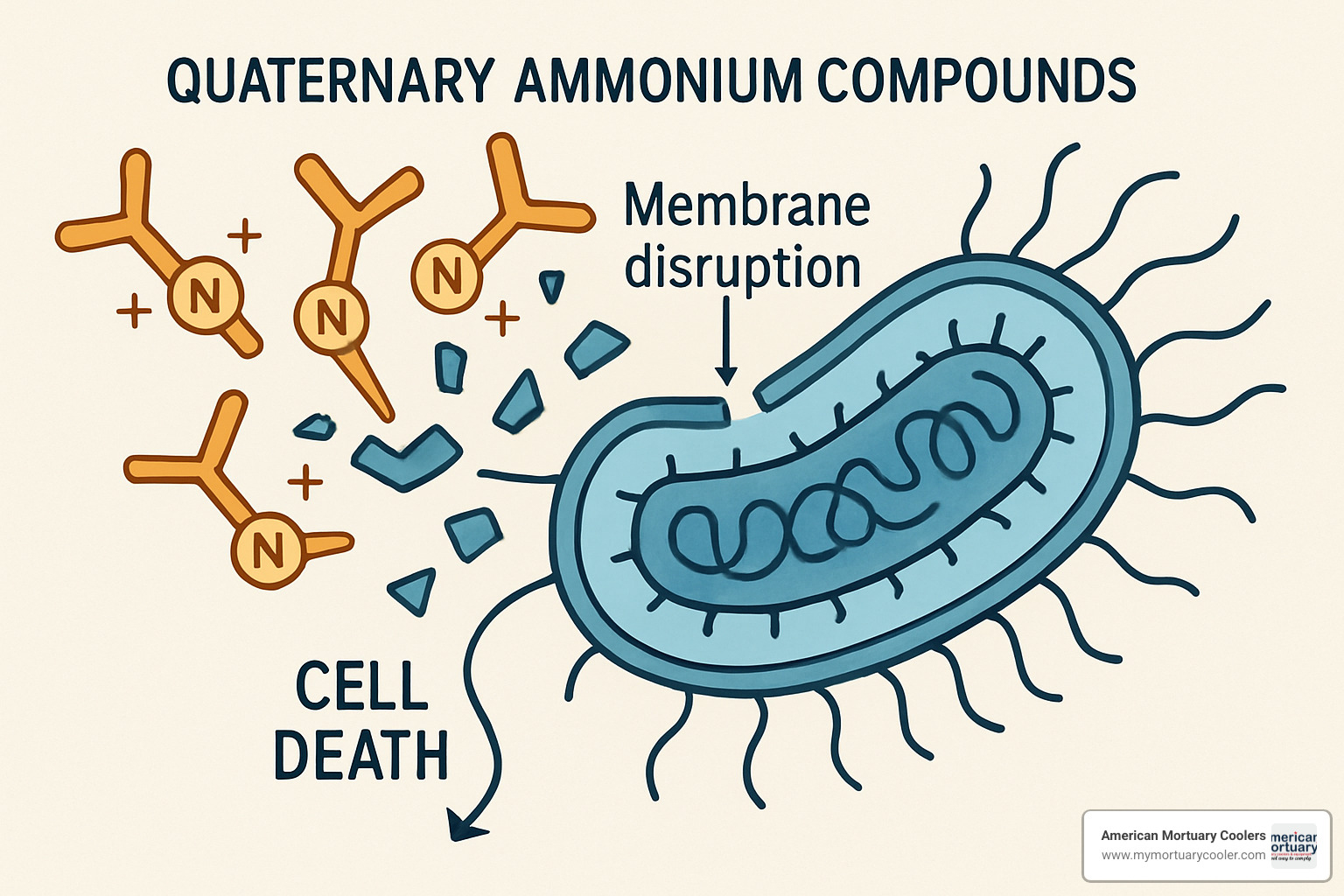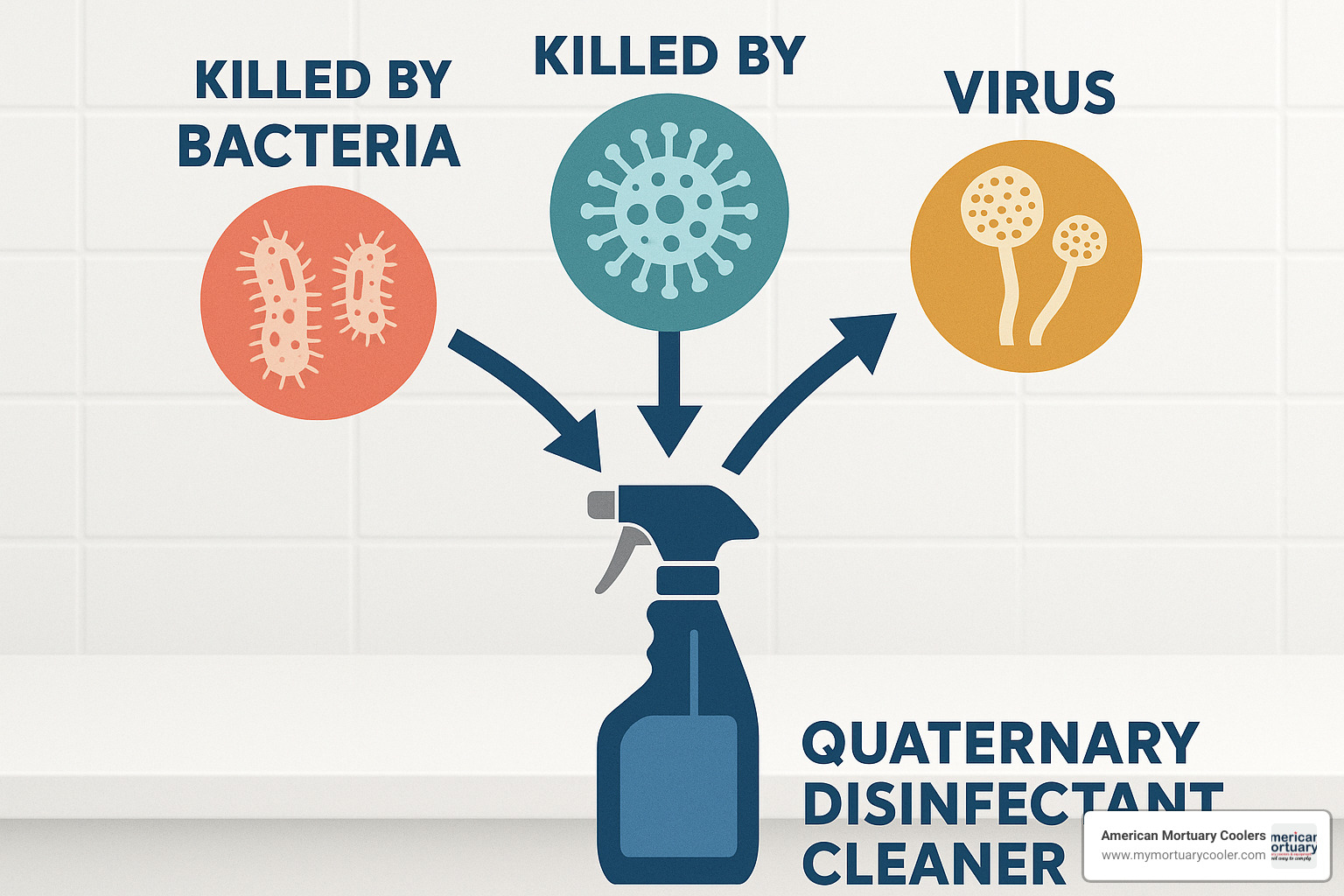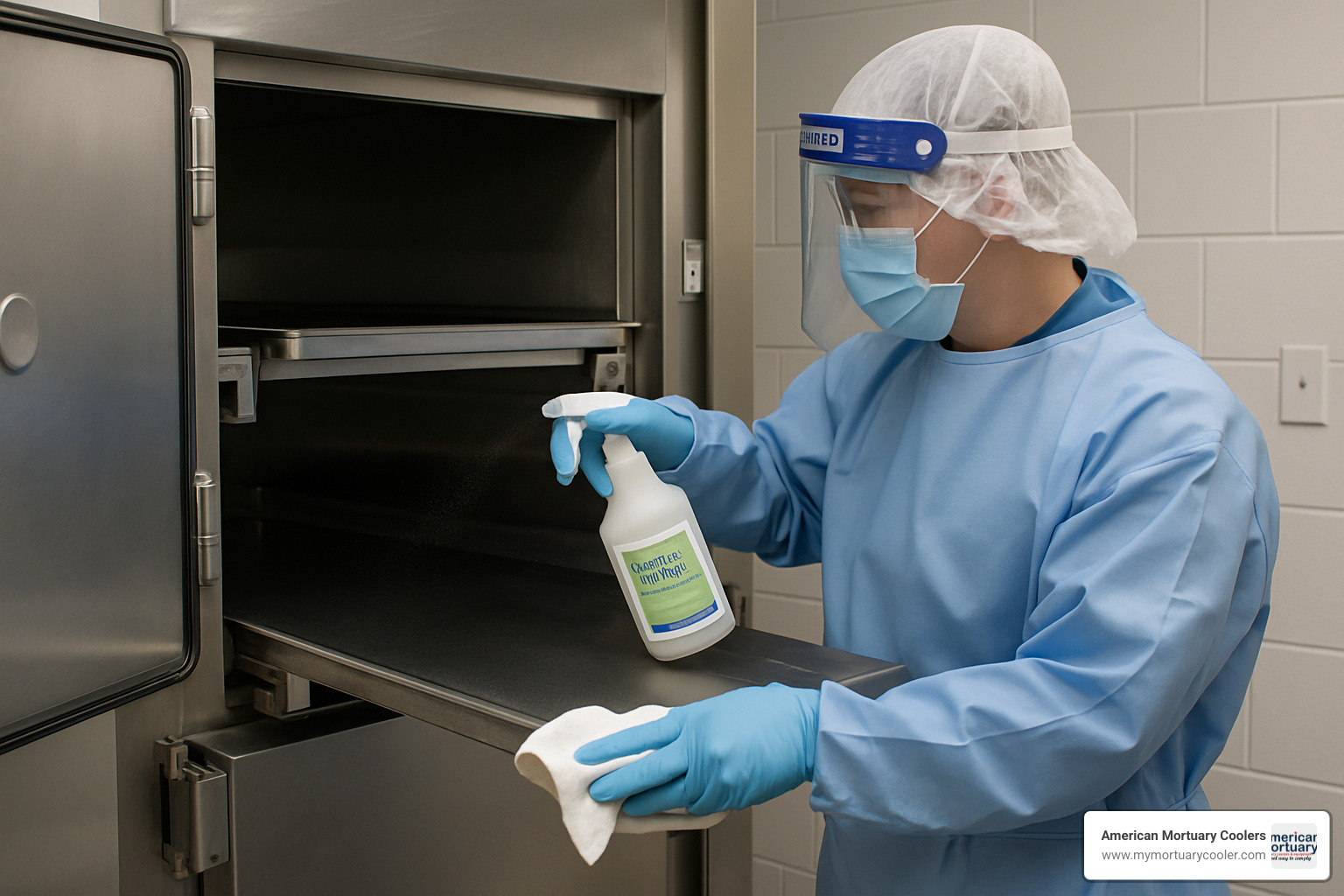
The Ultimate Guide to Lysol Quaternary Disinfectant Cleaner
Understanding Quaternary Disinfectants in Funeral Settings
Lysol quaternary disinfectant cleaner is a broad-spectrum antimicrobial solution designed to clean, disinfect, and deodorize in one step. For those searching for quick information:
| Key Facts About Lysol Quaternary Disinfectant Cleaner |
|---|
| - Kills 99.9% of viruses and bacteria on hard, non-porous surfaces |
| - Contains quaternary ammonium compounds as active ingredients |
| - Effective against SARS-CoV-2 (COVID-19) with 2-minute contact time |
| - Can be used as a spot sanitizer on soft surfaces |
| - EPA-registered disinfectant (EPA Reg. No. 777-66) |
| - Neutral pH formula safe for most surfaces |
| - Works in hard water up to 200 ppm |
In funeral homes and mortuary settings, maintaining proper sanitation is not just about cleanliness—it's about safety, compliance, and respect for the deceased and their families. Lysol quaternary disinfectant cleaner provides a powerful solution for disinfecting preparation rooms, transport vehicles, and common areas where pathogen control is essential.
Unlike bleach or alcohol-based products, quaternary ammonium compounds (often called "quats") offer extended residual protection while being gentler on surfaces. They work by disrupting cell membranes of microorganisms, effectively killing bacteria, enveloped viruses, and certain fungi when used according to label directions.
My name is Mortuary Cooler, and as a national supplier of mortuary refrigeration systems, I've recommended Lysol quaternary disinfectant cleaner to countless funeral professionals seeking effective solutions for sanitizing coolers, preparation surfaces, and transportation equipment.

Lysol Quaternary Disinfectant Cleaner: Formula, Registration & Core Uses
Working in the funeral industry means dealing with some of life's most sensitive moments – and having the right cleaning solutions makes all the difference. This professional-grade formula features a neutral pH balance that's gentle on surfaces but tough on pathogens. The active quaternary ammonium compounds provide powerful disinfection without the harsh effects of bleach or other alternatives.
What makes this product particularly valuable is its official EPA registration (EPA Reg. No. 777-66). It's earned spots on both EPA List N (for Coronavirus disinfectants) and List Q (for emerging viral pathogens including Monkeypox). This dual certification gives funeral directors peace of mind when handling deceased individuals with potentially infectious conditions.
One feature our customers particularly appreciate is the one-step clean-and-disinfect capability. When you're preparing for a service or managing multiple cases, saving those precious minutes matters. The formula works efficiently in healthcare settings, foodservice environments, and throughout funeral homes and preparation rooms.
Have fabric surfaces that need attention? Here's where Lysol quaternary disinfectant cleaner really shines. Unlike many disinfectants, it can safely spot-sanitize soft surfaces like upholstery in viewing rooms or in transport vehicles – areas that traditional disinfectants might damage.
According to scientific research on quats efficacy, these compounds offer an excellent balance of broad-spectrum pathogen control and material compatibility – exactly what you need in the sensitive environment of a funeral home.
Active Ingredients & How They Work
The science behind Lysol quaternary disinfectant cleaner is straightforward. Its two powerhouse ingredients are:
- Alkyl (50% C14, 40% C12, 10% C16) dimethyl benzyl ammonium chloride
- Didecyl dimethyl ammonium chloride
These quaternary ammonium compounds work by targeting and disrupting the cell membranes of bacteria, viruses, and fungi. When these compounds make contact, they penetrate the pathogen's protective outer layer, causing the cell contents to leak out – essentially destroying the microorganism from the inside out.
The formula gets extra cleaning power from supporting ingredients like surfactants that lift away dirt and stains, EDTA (which improves performance in hard water), and pH stabilizers for consistent effectiveness.

Primary Applications of Lysol Quaternary Disinfectant Cleaner
Hard, Non-Porous Surfaces are where this product truly excels. From embalming tables and preparation surfaces to the interior and exterior of mortuary coolers, this disinfectant provides thorough protection. Our clients regularly use it on body trays, transport equipment, countertops, sinks, door handles, and other high-touch areas throughout their facilities.
The Spot-Sanitizing Fabrics capability sets this product apart from many other disinfectants. Funeral directors appreciate being able to safely treat upholstery in viewing rooms, fabric surfaces in transport vehicles, and even curtains in preparation areas.
Mold & Mildew Control is another significant advantage. Preparation rooms and cooler units often deal with humidity challenges that can lead to mold growth. Lysol quaternary disinfectant cleaner helps inhibit mold on hard surfaces, treats areas prone to mildew, and maintains sanitary conditions in drainage areas.
Perhaps most appreciated is the product's Odor Neutralization properties. Rather than merely masking odors, it neutralizes them at the source while leaving behind a fresh, clean scent. This feature proves invaluable in preparation areas, transport vehicles, and viewing rooms where creating a comfortable environment for families is paramount.
Pathogen Spectrum & Surface Compatibility
When you're working in a funeral home, knowing exactly what germs your disinfectant can handle is essential for safety. Lysol quaternary disinfectant cleaner offers comprehensive protection against various microorganisms.
It works as a bactericide to kill harmful bacteria on contact, a virucide to eliminate viruses on surfaces, a fungicide to control fungi and prevent growth, and a mildewstat to keep mildew at bay. What makes this particularly valuable in funeral settings is how it performs under real-world conditions.
Unlike some disinfectants that fail when conditions aren't perfect, Lysol quaternary disinfectant cleaner maintains its effectiveness in hard water up to 200 ppm and even with moderate soil present—exactly the kind of challenging environments you'll encounter in preparation rooms and mortuary settings.

Germs Killed by Lysol Quaternary Disinfectant Cleaner
When we talk about "99.9% kill rate" with Lysol quaternary disinfectant cleaner, what does that actually mean for your funeral home? It means protection against an impressive range of pathogens that might be present when caring for the deceased.
For viruses, it's particularly relevant that it handles SARS-CoV-2 (the virus causing COVID-19) with just a 2-minute contact time. It also tackles Influenza A and B, Respiratory Syncytial Virus (RSV), Norovirus, Human Coronavirus, and even Monkeypox virus.
The bacterial coverage is equally robust. It eliminates tough pathogens like Staphylococcus aureus (including antibiotic-resistant MRSA), Pseudomonas aeruginosa, Salmonella enterica, E. coli, and Klebsiella pneumoniae.
For funeral directors concerned about mold and fungal growth in preparation areas, Lysol quaternary disinfectant cleaner also takes care of Aspergillus niger, Trichophyton interdigitale, and various mold and mildew species that might develop in the humid conditions often present in preparation rooms.
Safe & Unsafe Surfaces
Safe Surfaces include stainless steel of preparation tables, sinks, and cooler interiors. It works beautifully on most plastics and vinyl (think body trays and transport equipment), sealed wood surfaces, glazed ceramic tile, fiberglass fixtures, laminate countertops, glass, and painted walls with non-porous finishes.
Exercise caution with porous stone or concrete, unsealed wood, and some metals like aluminum, copper, and brass which may discolor with prolonged exposure. Natural marble or limestone surfaces should be tested in an inconspicuous area first.
Surfaces to avoid include food-contact surfaces unless you plan to rinse thoroughly with potable water afterward, fabrics that can't handle moisture, electronics without manufacturer approval, and medical devices.
Proper Application, Dilution & Safety Protocols
Working with Lysol quaternary disinfectant cleaner in funeral settings requires a careful balance between effective disinfection and maintaining a dignified environment.
The product comes in two forms: a concentrated formula that needs dilution and a ready-to-use spray. Most funeral professionals prefer the concentrate for regular cleaning routines since it's more economical for larger facilities.
For the concentrate, you'll typically use a 1:128 dilution (1 ounce per gallon of water) for everyday disinfection. For areas with heavier contamination, a stronger 1:64 mix (2 ounces per gallon) is recommended.
The application process is straightforward:
- Clean any visible soil or biological material from surfaces
- Apply your diluted solution using your preferred method—spray bottle, cloth, mop, or sponge
- Ensure the surface stays visibly wet for the full contact time
- Let it air dry naturally or wipe dry after the required time has passed
- For food-contact surfaces or areas that might touch the deceased's skin, rinse with clean water afterward

Always consult the product's Safety Data Sheets for complete safety information.
Personal Protective Equipment & Handling
When working with Lysol quaternary disinfectant cleaner, proper protection is essential:
Nitrile gloves protect your hands from repeated exposure that can dry and irritate skin. Eye protection is important, especially when mixing concentrate or working overhead where splashing might occur.
For messier cleanup jobs, a lab coat or apron will protect your clothes. While respiratory protection isn't usually necessary with good ventilation, smaller prep rooms with limited airflow may benefit from basic masks during extensive cleaning.
If you're looking to upgrade your PPE setup, check out our guide on PPE selection for mortuary environments.
Remember the basics of safe handling: read labels, mix in well-ventilated areas, never combine with bleach, and always store in the original container.
Dilution Ratios & Contact Times
For general cleaning, the standard 1:128 dilution (1 oz per gallon) works perfectly. For areas with heavier contamination, use 1:64 (2 oz per gallon).
Contact time is crucial: COVID-19 disinfection needs 2 minutes of wet contact time, general bacterial disinfection requires 5 minutes, and fungal control needs 10 minutes of wet contact time.

Storage & Environmental Considerations
Store Lysol quaternary disinfectant cleaner in a cool, dry area away from direct sunlight, which can degrade the active ingredients. Always keep it in the original container with the label intact.
Temperature matters—aim for storage between 40°F and 120°F (4°C-49°C). From an environmental standpoint, while the concentrate is classified as corrosive to metals (UN1903), its environmental impact is relatively low when properly diluted.
For disposal, never pour concentrate down drains or into waterways. Diluted product can typically go into sanitary sewers according to local regulations. Empty containers should be triple-rinsed and recycled or disposed of properly.
Comparing Lysol Quaternary Disinfectant Cleaner to Alternatives
When I talk to funeral directors about disinfection options, they often ask how Lysol quaternary disinfectant cleaner compares to other products. Let's break down the main differences:
Bleach (sodium hypochlorite) is effective but harsh. It kills most pathogens but has a strong smell and tends to corrode metal surfaces, making it problematic in preparation rooms and around mortuary coolers.
Hydrogen peroxide-based disinfectants are gentler and break down into water and oxygen, leaving no harmful residue. They're excellent for sensitive equipment but typically cost more and have a shorter shelf life.
Alcohol-based products work fast and evaporate quickly, but don't stay on surfaces long enough to tackle tougher pathogens and can damage certain finishes over time.
| Disinfectant Type | Advantages | Limitations | Best Applications |
|---|---|---|---|
| Lysol Quaternary | Non-corrosive, residual activity, pleasant scent, soft surface application | Longer contact times, limited sporicidal activity | General disinfection, odor control, soft surfaces |
| Bleach | Fast-acting, inexpensive, broad spectrum | Corrosive, unstable, strong odor | Heavy contamination, outbreak situations |
| Hydrogen Peroxide | No residue, environmentally friendly | More expensive, shorter shelf life | Medical equipment, sensitive surfaces |
| Alcohol-Based | Fast-drying, no residue | Limited contact time, flammable | Quick surface disinfection, electronics |
In my years working with funeral homes, I've found that Lysol quaternary disinfectant cleaner hits a sweet spot for daily use in mortuary settings. It's gentle enough for stainless steel preparation tables without corrosion concerns, yet powerful enough to handle common pathogens.
Advantages & Limitations
Advantages: The non-corrosive, neutral pH formula means you can clean your mortuary cooler without worrying about damage. The pleasant scent creates a more dignified atmosphere, which matters when families might visit preparation areas.
The one-step cleaning and disinfection process saves valuable time when you're busy with multiple cases. The ability to use it on soft surfaces is particularly valuable in funeral homes—from upholstery in arrangement rooms to fabric in removal vehicles.
Limitations: Surfaces must remain wet for 2-10 minutes depending on the target pathogen, which can be challenging in a busy prep room. For tough pathogens like C. difficile spores, you might need something stronger like bleach in specific situations.
Heavy soiling from bodily fluids requires pre-cleaning before disinfecting. And remember, food-contact surfaces need rinsing afterward.
Industry Use Cases & Emerging Pathogens
At American Mortuary Coolers, we see how Lysol quaternary disinfectant cleaner has become a trusted solution in numerous settings, from healthcare facilities to foodservice operations, schools, and mortuary preparation rooms.
What makes this disinfectant particularly valuable in funeral settings is its multitasking ability. It controls pathogens, manages biological odors, preserves expensive equipment surfaces, and helps keep staff safe when handling potentially infectious remains.
When COVID-19 hit, disinfection protocols took center stage. Lysol quaternary disinfectant cleaner quickly earned its place with proven effectiveness against SARS-CoV-2 in just a 2-minute contact time. Its inclusion on EPA List Q for effectiveness against emerging viral pathogens like Monkeypox has made it even more valuable.
For more guidance on maintaining safety in morgue environments, check out our article on Essential Safety Protocols for Morgue Freezers.
Lysol Quaternary Disinfectant Cleaner in Funeral Settings
In funeral homes across America, I've seen Lysol quaternary disinfectant cleaner used in specific ways:
Body Tray Sanitation: Stainless steel trays in mortuary coolers need thorough disinfection between cases. The quaternary formula does the job without corroding materials.
Embalming Tables: The one-step cleaner-disinfectant properties make sanitizing preparation tables quicker while ensuring thorough cleaning.
Transport Equipment: Vehicles and equipment used to move the deceased require regular disinfection. This product works on both hard surfaces and upholstery.
Odor Control: Maintaining a respectful, odor-free environment is crucial. Rather than just masking odors, Lysol quaternary disinfectant cleaner neutralizes biological odors at their source.
Cooler Maintenance: Regular disinfection prevents cross-contamination and extends the life of your equipment—an investment worth protecting.
Future-Proofing Against Emerging Viruses
The funeral industry needs to stay ready for whatever comes next. Lysol quaternary disinfectant cleaner's inclusion on both EPA List N (COVID-19) and List Q (Emerging Viral Pathogens) provides reassurance.
The product has been tested using AOAC Use-Dilution Method standards, ensuring it will stand up to a wide range of pathogens, even ones we haven't encountered yet.
For funeral homes developing pandemic preparedness plans, incorporate EPA-registered disinfectants with broad-spectrum efficacy. Keep an updated inventory of approved disinfectants, regularly review EPA lists for updates, and ensure staff training on proper application techniques and contact times.
Frequently Asked Questions
Here are the questions our customers ask most often about Lysol quaternary disinfectant cleaner:
Does it kill COVID-19?
Yes. Lysol quaternary disinfectant cleaner effectively kills SARS-CoV-2 with just a 2-minute contact time on hard, non-porous surfaces. It's officially included on the EPA's List N for coronavirus disinfectants, giving funeral professionals peace of mind when handling deceased individuals who may have had COVID-19.
Can I use it on food-contact surfaces?
Yes, but you must thoroughly rinse these areas with clean, potable water afterward. This same principle applies in preparation rooms – any surfaces that might contact the deceased's skin or your staff's hands should be rinsed after disinfection.
What PPE is mandatory for routine use?
For everyday use of properly diluted solution: wear chemical-resistant nitrile gloves and eye protection if there's any splashing risk.
When handling the undiluted product:
- Chemical-resistant gloves
- Eye protection (safety glasses or goggles)
- Protective clothing like a lab coat or apron
- Good ventilation in your mixing area
One safety tip: install an eyewash station in your prep room as a precaution.
How long does the disinfectant remain effective after application?
While Lysol quaternary disinfectant cleaner provides some residual antimicrobial activity after drying, don't count on it for ongoing protection. Re-disinfect surfaces:
- Whenever visible soiling occurs
- Between deceased individuals
- At least once daily in high-touch areas
- According to your facility's established protocols
Is it safe to use in mortuary coolers?
Yes. At American Mortuary Coolers, we design our refrigeration units with materials compatible with quaternary ammonium disinfectants. Take these precautions:
- Unplug the unit before cleaning interior electrical components
- Allow surfaces to dry completely before returning to service
- Ensure adequate ventilation during application
- Never spray directly into cooling mechanisms or electrical components
Can I mix it with other cleaning products?
No. Lysol quaternary disinfectant cleaner should never be mixed with other cleaning products. Mixing with bleach can create toxic chlorine gas. Never combine with ammonia-based cleaners, acidic products, or other disinfectants.
How should I dispose of unused product?
For small amounts of diluted solution, most local regulations allow disposal down the drain with plenty of running water. For concentrate or larger quantities:
- Never pour down storm drains or into waterways
- Check with local hazardous waste authorities about proper disposal methods
- Consider using a licensed waste disposal contractor
For empty containers, triple-rinse before recycling or disposing according to local guidelines.
Conclusion & Next Steps
We've explored how Lysol quaternary disinfectant cleaner plays a vital role in funeral and mortuary settings. This quaternary ammonium-based disinfectant effectively kills pathogens while being gentle on important surfaces in your funeral home.
At American Mortuary Coolers, we see disinfection as one piece of the puzzle in running a successful mortuary operation. Our coolers and preparation equipment are built with thorough cleaning in mind – featuring surfaces compatible with quaternary disinfectants.
Ready to improve your funeral home's disinfection protocols? Here's what we recommend:
- Create a clear disinfection workflow in writing, specifying products, dilution ratios, contact times, and frequency
- Ensure your staff understands not just what to do, but why it matters
- Keep a simple disinfection log to demonstrate your commitment to standards
- Regularly check for EPA updates about new pathogens and disinfectant effectiveness
- Coordinate your disinfection schedule with your equipment maintenance calendar
Good disinfection practices show your dedication to maintaining dignity and respect for the deceased and the families you serve. In the funeral business, these details matter deeply.
Based in Tennessee but serving funeral homes across the contiguous 48 states, American Mortuary Coolers specializes in crafting custom refrigeration solutions for your specific needs. Our expertise extends beyond refrigeration to the complete preparation room environment.
Want to learn more about our mortuary coolers, preparation room equipment, or integrated solutions for your funeral facility? Visit our cooler & prep-room equipment hub for helpful resources.
By pairing quality equipment with effective disinfection protocols using products like Lysol quaternary disinfectant cleaner, you create an environment that's not just safe and sanitary – but one that reflects the care and respect that defines your service to families during their most difficult moments.



